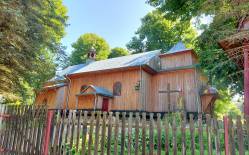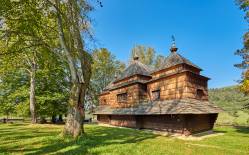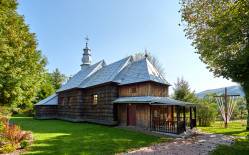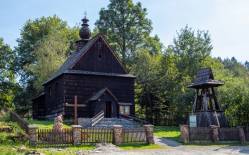The former Greek-Catholic Tserkva of St. Demetrius was built in 1814. During WWII its dome was hit by a mortar bomb. After the war the tserkva was reconstructed, yet the dome was not rebuilt.
During the pre-war period the church was restored jointly by the local Greek Catholics and Roman Catholics, to be used by both denominations. However, in 1938 the latter refused to share the place, which led to riots. The conflict was resolved by an intervention of police and army. The tserkva was closed until 1941. After Germans entered the areas previously occupied by Soviet Russia, the church was again opened for the local people and operated until the time of the forced resettlements in 1947. Since that time, it has been used by Roman Catholic Church.
The tserkva, oriented eastward, is clad with vertical wood planks, and its foundations are covered with a shingled apron. The two-part building comprises a chancel enclosed with semi-hexagonal walls, and on the northern side adjoined by a sacristy. On the western side there is a small post-and-frame tower comprising the vestibule, and covered with hip roof. The main body of the building is covered with gable roof; over the chancel there is a turret.
Inside there are flat ceilings and a gallery supported on pillars. The original furnishings have not been preserved. The high altar and the side altars are neo-Baroque in style. The former holds a picture of Our Lady of Perpetual Help.
In the vicinity we can see a 19th century neo-Gothic tomb shrine as well as the parish cemetery.
The deepest borehole in Poland was executed in Kuźmina, going 7541 metres downward. The drilling took five years. The borehole was used by researchers to examine the geological structure of the Carpathians.
Photo: Podkarpackie Regional Tourist Board
Gallery

Recommended venues on the Trail



This website has been modernized with the financial support of the European Union under the Cross-Border Cooperation Programme Poland-Belarus-Ukraine 2014-2020. The responsibility for its content lies solely with the Podkarpackie Regional Tourism Board and cannot, in any case, be treated as a reflection of the position of the European Union, the Managing Authority, or the Joint Technical Secretariat of the Cross-Border Cooperation Programme Poland-Belarus-Ukraine 2014-2020.













